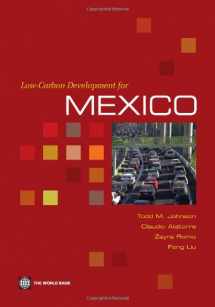
Low-Carbon Development for Mexico
ISBN-13:
9780821381229
ISBN-10:
0821381229
Author:
Todd M. Johnson, Feng Liu, Zayra Romo, Claudio Alatorre
Publication date:
2009
Publisher:
World Bank Publications
Format:
Paperback
184 pages
FREE US shipping
Book details
ISBN-13:
9780821381229
ISBN-10:
0821381229
Author:
Todd M. Johnson, Feng Liu, Zayra Romo, Claudio Alatorre
Publication date:
2009
Publisher:
World Bank Publications
Format:
Paperback
184 pages
Summary
Low-Carbon Development for Mexico (ISBN-13: 9780821381229 and ISBN-10: 0821381229), written by authors
Todd M. Johnson, Feng Liu, Zayra Romo, Claudio Alatorre, was published by World Bank Publications in 2009.
With an overall rating of 4.3 stars, it's a notable title among other
books. You can easily purchase or rent Low-Carbon Development for Mexico (Paperback) from BooksRun,
along with many other new and used
books
and textbooks.
And, if you're looking to sell your copy, our current buyback offer is $0.56.
Description
To reduce the risk of climate change impacts it is necessary for the world to lower the carbon intensity of economic development. 'Low-Carbon Development for Mexico' estimates the net costs, greenhouse gas (GHG) emission reductions, and investment that would be needed to achieve a low-carbon scenario in Mexico to the year 2030.Among the key findings of the study are the following: • Energy efficiency. Improving energy end-use efficiency in the industrial, residential, and public sectors is the least-cost option for reducing carbon emissions and can be achieved by accelerating current Mexican programs and policies. • Supply efficiency and renewable energy. Mexico can lower the carbon intensity of the economy by improving the efficiency of energy supply in the electric power and petroleum industries, and by expanding the adoption of renewable energy technologies such as wind, biomass, small hydro, and geothermal. • Public transport and vehicle fleet efficiency. Transport is the largest and fastest growing contributor of GHG emissions in Mexico, the majority of which comes from road transport. The greatest potential for reducing transport emissions lies with improving the quality and efficiency of urban transport, including more efficient vehicles and the design and organization of cities and public transport systems. • Forestry – significant potential with large co-benefits. Measures to reduce emissions from deforestation and forest degradation (REDD), along with afforestation and commercial plantations, are among the largest GHG mitigation options in Mexico, and could provide numerous social and environmental benefits in rural areas. • By undertaking a limited number of low-carbon interventions that are technologically and financially viable today, Mexico could hold carbon emissions relatively constant over the coming two decades while maintaining a vigorous rate of economic and social development. The costs of such a program would be relatively modest, but would require a range of regulatory and institutional changes to achieve, especially in the energy and transport sectors.


We would LOVE it if you could help us and other readers by reviewing the book
Book review

Congratulations! We have received your book review.
{user}
{createdAt}
by {truncated_author}


